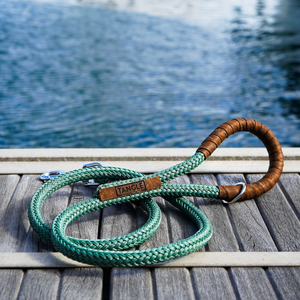This Halloween, we're coming as a ghost net.
Ghost nets are an alarming and hidden threat to the health of our oceans. The discourse around ocean plastic is often dominated by microplastics such as plastic straws, bags, and bottles. Don't get us wrong, they are of course still a massive danger, however, ghost nets are arguably a much bigger threat to marine life and the ocean with over 640,000 tonnes entering our oceans each year.
In this blog post, we'll explore the effects of ghost nets on our oceans and what can be done to reduce their impact.
What are Ghost Nets and How do They Impact the Ocean?
Ghost nets are abandoned or lost fishing gear that continue to drift in the ocean, wreaking havoc on marine life and contributing to the plastic pollution crisis. These discarded nets, lines, and traps can float for thousands of miles, entangling unsuspecting sea creatures like fish, sea turtles, dolphins, and more.
The impact is devastating, leading to physical injuries, suffocation, and even death for these animals. The consequences for our oceans are severe as well, as the entangled nets introduce more plastic into the ecosystem, exacerbating the plastic pollution problem.
Ghost nets pose a hidden and alarming threat to the health of our oceans, endangering ocean life and contributing to the degradation of marine habitats. Understanding the impact of ghost nets is crucial for promoting ocean conservation and finding solutions to save the ocean from further harm.
The Scale of the Problem: Statistics and Data
The scale of the ghost net problem in our oceans is truly staggering. According to research conducted by the World Animal Protection, an estimated 640,000 tons of fishing gear is lost or abandoned in our seas each year. This means that ghost nets account for nearly 10% of all ocean plastic pollution. Furthermore, a study published in the journal Scientific Reports found that ghost nets were responsible for trapping and killing over 5,000 marine animals, including turtles, dolphins, and whales, in just a three-year period - and this is only those that we know of.
These statistics paint a scary picture of the devastating impact that ghost nets have on our marine ecosystems. The urgency to address this problem cannot be understated. It is essential that we take immediate action to prevent further harm to our oceans and the incredible creatures that call it home.
The Origins of Ghost Nets: Who's Responsible for This Pollution?
Ghost nets, these silent killers of the ocean, have a grim origin. While it is true that ghost nets are discarded or lost fishing gear, the responsibility for this pollution does not solely lie with fishermen. Ghost nets are often a result of accidents, severe weather conditions, or even intentional dumping. However, it's crucial to recognize that the fishing industry plays a significant role in contributing to this problem. The demand for seafood drives fishing activities, and when gear is lost or abandoned, it becomes another addition to the growing ghost net crisis. It's not just fishermen who need to take responsibility; consumers and governments also have a role to play in combating this issue.
Implementing stricter regulations on fishing gear disposal, promoting sustainable fishing practices, and raising awareness about the impact of ghost nets are essential steps to address this pressing issue.
If you know Tangle, you'll know that we are partnering with ports across the UK to incentivize fishers to return any damaged nets to us so that we recycle it and use it to make our products. The material is super robust and definitely has a better purpose on land than at the bottom of the ocean.
Marine Life at Risk: Species Affected by Ghost Nets
Marine life is facing a terrifying threat from ghost nets. These discarded or lost fishing gear continue to haunt our oceans, entangling and trapping unsuspecting species.
The devastating impact of ghost nets cannot be ignored. In fact, recent incidents of whale entanglement have brought this issue to the forefront, if you have seen David Attenborough's 'Wild Isles', you will have seen a member of the tracked Orca pod fall victim to entanglement and sadly beached itself.
Sea turtles are particularly vulnerable, as they mistake the floating nets for jellyfish and become trapped. From small fish to large mammals, no species is immune to the deadly grasp of ghost nets. The scale of the problem is enormous, but through collective efforts, we can combat this frightening phenomenon and protect our precious marine ecosystems.
Global Efforts to Combat Ghost Nets: Success Stories and Best Practices
Many organizations and communities around the world have taken steps to combat ghost nets and reduce the plastic pollution crisis. Tangle has partnered with Ghost Fishing UK, to support their efforts on the frontlines tackling the ghost net problem (please do check them out!).
All across the world, there are rescue operations and charities in place to rescue wildlife. We believe that we need to stop the problem at the source to ensure ghost nets stay out of our oceans. It's no easy task, as we mentioned earlier there is no sole responsibility for this. Something that we champion at Tangle is spreading awareness about the problem. Not many people are aware of the ghost net problem so, tell a friend, send them this article and even get in touch with your local government.
By continuing to raise awareness, supporting initiatives to reduce plastic waste, purchasing products that support these efforts, and promoting sustainable fishing practices, we can make a difference and create a brighter future for our oceans and the creatures that inhabit them.
What Can We Do as Individuals? Practical Tips for Reducing Our Plastic Footprint
As individuals, we have the power to make a difference in reducing our plastic footprint and combating the threat of ghost nets. Here are some practical tips that you can incorporate into your daily life to contribute to a cleaner and safer ocean:
- Reduce single-use plastic: Say no to plastic straws, cutlery, and bags. Opt for reusable alternatives like metal or bamboo straws, eco-friendly cutlery sets, and cloth bags.
- Choose sustainable seafood: Support fisheries that use sustainable fishing practices and avoid seafood products that contribute to ghost nets and overfishing.
- Properly dispose of fishing gear: If you're a fisherman or know someone who is, make sure to properly dispose of fishing gear and report lost or abandoned nets to local authorities.
- Participate in beach clean-ups: Join local clean-up events or organize your own. Removing plastic waste from beaches can prevent it from entering the ocean and becoming ghost nets.
- Support organizations and initiatives: Donate to or volunteer with organizations that work towards ocean conservation and the removal of ghost nets. Stay informed about their efforts and spread awareness to others. (Check out our range of products made from recycled fishing nets).
Remember, every small action counts. By making conscious choices and spreading awareness, we can all play a role in protecting our oceans and marine life from the threats of ghost nets. Let's take action and create a better future for our oceans.



